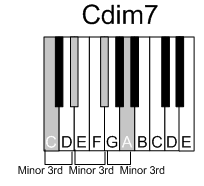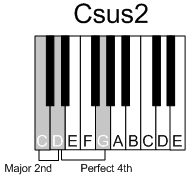Use this guide to learn the fundamentals of chord theory and improve your chord-style playing!
Introduction
The principles in this chord
guide will enable you to determine how to play basic chords in any key without
consulting a chord guide or memorizing long lists of chords.
Foundational
Knowledge
With one notable (and debatable) exception,
a chord is any combination of three or more notes. The distance between chord
notes is called an interval, and a chord usually consists of two or more
intervals. Intervals can be measured in half-steps. A half-step is the distance
between a particular piano key and the key right next to it, which may be black
or white. Chord names begin with the root note and may be followed by the chord
type as well as any chord extensions, which are extra notes added to the chord.
Chord notes can be played in any
order and any octave, although with varying results. Reasons for changing the
order of a chord’s notes include adding variety to a performance or increasing
playability by reducing hand movement. Chord notes can be played at the same
time, or one after the other. For a basic accompaniment, play the chord notes
at the same time with the left hand while playing the melody with the right.
C has been selected as the chord
root in all of the following examples. However, the process of determining how
to play a chord is the same no matter what root note is selected. Simply count
half-steps to identify chord intervals.
Major chords
Identification: Whenever
you see a chord letter with no other information next to it, it’s a major
chord.
Chord symbol example: C
Bottom interval: Major third (4
half-steps)
Top interval: Minor third (3
half-steps)
Keyboard example:
Minor chords
Identification: Whenever
you see a chord letter with a small “m” next to it, it’s a minor chord.
Chord symbol example: Cm
Bottom interval: Minor third (3
half-steps)
Top interval: Major third (4
half-steps)
Keyboard example:

Diminished chords
Identification: Whenever
you see a chord letter with a degree symbol next to it, it’s a diminished
chord.
Chord symbol example: C°
Bottom interval: Minor third (3
half-steps)
Top interval: Minor third (3
half-steps)
Keyboard example:
Augmented chords
Identification: Whenever
you see a chord letter with a + next to it, it’s an augmented chord.
Chord symbol example: C+
Bottom interval: Major third (4
half-steps)
Top interval: Major third (4
half-steps)
Keyboard example:
Fifth chords (also known as power chords)
Identification: Whenever
you see a chord letter with a 5 next to it, it’s a fifth chord.
Chord symbol example: C5
Interval: Perfect 5th (7 half-steps)
Keyboard example:
(Dominant) seventh chords
Identification: Whenever
you see a chord letter with a 7 next to it, it’s a (dominant) seventh chord. Dominant
seventh chords are usually just referred to as seventh chords. In practice they
are often inverted and the 5th tone dropped. For example, instead of
C, E, G and Bb the player uses E, Bb and C.
Chord symbol example: C7
Bottom interval: Major third (4
half-steps)
Middle interval: Minor third (3
half-steps)
Top interval: Minor third (3
half-steps)
Keyboard example:
Major seventh chords
Identification: Whenever
you see a chord letter with maj7 next to it, it’s a major seventh chord.
Chord symbol example: Cmaj7
Bottom interval: Major third (4
half-steps)
Middle interval: Minor third (3
half-steps)
Top interval: Major third (4
half-steps)
Keyboard example:
Minor seventh chords
Identification: Whenever
you see a chord letter with an m7 next to it, it’s a minor seventh chord.
Chord symbol example: Cm7
Bottom interval: Minor third (3
half-steps)
Middle interval: Major third (4
half-steps)
Top interval: Minor third (3
half-steps)
Keyboard example:
Diminished seventh chords
Identification: Whenever
you see a chord letter with a °7 next to it, it’s a diminished seventh chord.
Chord symbol example: C°7
Bottom interval: Minor third (3
half-steps)
Middle interval: Minor third (3
half-steps)
Top interval: Minor third (3
half-steps)
Keyboard example:
Sus2 chords
Identification: Whenever
you see a chord letter with a sus2 next to it, it’s a suspended second chord.
Chord symbol example: Csus2
Bottom interval: Major second (2
half-steps)
Top interval: Perfect fourth (5
half-steps)
Keyboard example:
Sus(pended) or sus4 chords
Identification: Whenever
you see a chord letter with a sus or sus4 next to it, it’s a suspended fourth chord.
Chord symbol example: Csus or Csus4
Bottom interval: Perfect fourth (5
half-steps)
Top interval: Major second (2
half-steps)
Keyboard example:
7sus(pended) or 7sus4 chords
Identification: Whenever
you see a chord letter with a 7sus or 7sus4 next to it, it’s a seven suspended
fourth chord.
Chord symbol example: C7sus or C7sus4
Bottom interval: Perfect fourth (5
half-steps)
Middle interval: Major second (2
half-steps)
Top interval: Minor third (3
half-steps)
Keyboard example:
Slash chords
Identification: Whenever
you see a chord letter with a slash and another letter next to it, it’s a slash
chord. This doesn’t mean that you can play a C chord or a G chord. It just means that you should play the C chord with a
G as the lowest note. Beginning players can safely ignore the letter to the
right of the slash and just play the chord on the left side of the slash.
Chord symbol example: C/G
Interval: Varies depending on the slash
chord
Keyboard example:
Other chords
More sophisticated chords such as Am7b5, F13, etc., are
beyond the scope of this guide.











